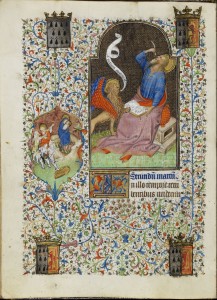Reflectance spectroscopy in the ultraviolet, visible and near-infrared (UV-vis-NIR) range gathers structural information on the materials present in the surface layers and occasionally on the underlayers when the paint layers are thin. The identification of materials is based on electronic transitions giving rise to colour (visible-NIR range up to ~900 nm) or on the presence of characteristic absorption bands due to functional groups such as sulfates, carbonates, etc. (NIR range up to 2500 nm). The NIR signal is largely due to the parchment support and may be diagnostic of ageing/alterations of the parchment. The major drawbacks of this technique are the complexity of the spectra in the case of mixtures and the relatively low spatial resolution (~3 mm spot-size). Reflectance spectra are included in many of the hotspots you can explore on this website.
The reflectance spectra of our manuscripts were recorded with a FieldSpec4 spectrometer (ASDi/PANalytical) with integrated light source and a bifurcated fibre-optic probe kept parallel to the surface normal. When an optic fibre is used, as is the case here, this analytical method is often called 'FORS' - fibre-optic reflectance spectroscopy.
The spectral resolution of our instrument is 3 nm at 700 nm, and 10 nm at 1400 and 2100 nm. The instrument includes a modular Silicon array and two Peltier-cooled InGaAs detectors. The measurement spot size is about 3 mm in diameter. Sixty-four scans were acquired for each spectrum for a total acquisition time of approximately 8 seconds. Calibration to reflectance was obtained using a Spectralon© standard. Spectral interpretation was based on both in-house and published reference databases.

















